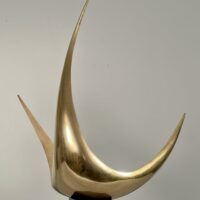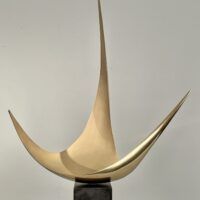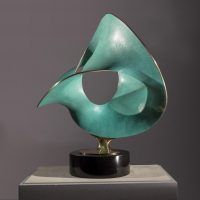









Robert Engman (American, 1927-2018)
Untitled, c. 1954
Bronze with dual, polished and matte surfaces
27 H. x 24 ¼ W. x 17 ¼ D inches
Mounted on original marble plinth, 8 H. inches
Overall height: 35 inches


Robert Engman (American, 1927–2018)
Iyengar
Polished bronze, 14 x 18 x 12 in.
Marble base: 1 1/4 in.
Stamped edge: Edition of 12



Robert Engman (American, 1927–2018)
Moon
Bronze, 12 3/4 x 8 3/4 in.
Edition of 15


Robert Engman (American, 1927–2018)
Linear Series, Oliver
Fabricated steel rods, 21 3/4 H. x 28 W. x 28 D. inches
Mounted on wood base: 5 1/4 H. inches
Edition of 10


Robert Engman (American, 1927–2018)
Three Warped Circles
Bronze, green patina, on marble base
27 H. x 29 3 ⁄4 W. x 23 1/2 D. inches
Edition of 8 casts






Robert Engman (American, 1927–2018)
Iyengar
Cast stainless steel, 14 x 18 x 12 in.
Marble base: 1 1/4 in.
Stamped edge: Edition of 12
Engman was born in 1927 to parents who had emigrated from Sweden. He joined the Navy at the age of 15, serving in World War II in the Pacific. He graduated from the Rhode Island School of Design with a BFA, and from Yale University with an MFA in 1955, in Painting and in Sculpture, where he studied with Josef Albers. Albers wrote of him: “Only a few independent ones were courageous enough to concentrate on the plane—the in-between of volume and line—as a broad sculptural concept and promise.”
Engman has taught sculpture at Yale University, and at the University of Pennsylvania (“Penn”).
Students collaborated with Engman to create the Peace Symbol (1967) sculpture which was installed in front of the Van Pelt Library at Penn in 1983.
One of his best-known sculptures, Triune (1975), stands at the southwest corner of Philadelphia City Hall. Another work, Kings (1975) is at 78th and Lindbergh Streets, also in Philadelphia.
In his work, he often explores minimal surface intersections of geometric forms. Others have been fascinated with the science and mathematics of such surfaces, including the late R. Buckminster Fuller.